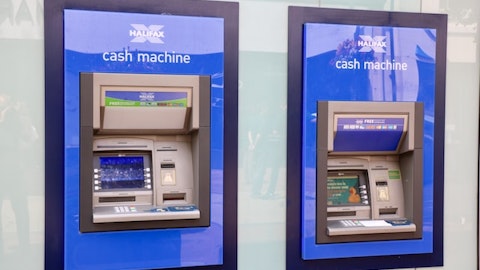Rob Gorman: Yeah. So, it’s about $3 billion in terms of their total assets at closing. So, we expect we’ll continue to grow. I think we’re at $24.5 billion, pro forma 3/31 number. So, we expect to grow the loan book about 5% on a combined basis, on a full-year basis we reported. So, you’ll see those assets grow accordingly.
Casey Whitman: Okay. Understood. And then maybe just a bigger picture question on M&A. Obviously, you just closed American National. You’ve got the systems conversion, I think, going on in May. John, can you walk us through sort of your thoughts around future M&A and how we should think about that [indiscernible]?
John Asbury: Sure. It’s hard to think about anything but a successful conversion and integration of American National Bank right now. But I understand your question because we always do try to think a couple of steps ahead. Casey, nothing has changed in terms of our declared priorities. First, organic performance of this bank that now includes American National. Make the most of what we have right here, right now. That is by far the most important thing we have to do. Second, innovation and transformation activities. We have a lot of work underway there. We have a new mobile and online banking platform that’s coming online this year as well. A lot went on in the technology space. And we see continued opportunity for automation, which will pull expense out, improve quality.
Third, and it’s a distant third, would be strategic investment to include a whole bank acquisition. So, we have had other conversations that have gone on for years, just like American National Bank went on for years. You never know what the timing would be. If all goes well with American National Bank and everything is in good order, would we consider something else consistent with what we described before? We might, if it made strategic and financial sense. But I hope we’re being clear that first things come first.
Casey Whitman: Great. Thank you for the call.
John Asbury: Thanks, Casey. And, Didi, we’re ready for our next caller, please.
Operator: Thank you. One moment. And our next question comes from Steve Moss of Raymond James.
John Asbury: Good morning, Steve. Have we lost Steve?
Operator: He removed from queue. Let me promote the next person.
John Asbury: Okay.
Operator: Our next question comes from David Bishop of Hovde Group.
John Asbury: Hi, David. Good morning.
Operator: David, your line is open.
David Bishop: Hey, sorry about that. Can you hear me?
John Asbury: Yeah. You’re making me nervous, David.
David Bishop: Sorry, John.
John Asbury: Congratulations on being promoted. Thank you for calling in.
David Bishop: Hey, John, just curious, obviously, you mentioned at the beginning the resilience in the economy and the opportunities in the new markets in North Carolina. Just curious how to reconcile that with what appears to be maybe conservative guidance in terms of loan growth or are there some portfolios maybe you’re going to run off post close that sort of maybe provides the lower end of the loan growth guidance? Just curious, maybe just reconcile maybe some of the guidance versus the economic reality.
John Asbury: Yes. There are no runoff portfolios associated with American National Bank. The only runoff portfolio in our bank, I suppose you would say, would be the indirect auto finance. We have things like office that we certainly don’t have any appetite for taking on new exposure as well. But, David, I think, perhaps David Ring, Head of Wholesale Banking of commercial-related businesses can comment here. We do think that clients are being cautious. We feel good about these economies. We feel good about credit. But there is less investment going on right now. So, I think the mid-single-digit loan growth guidance, where we stand today is a good expectation. Could it be better than that? I think it could. Dave, what is your view?
David Ring: Well, there are — we’ve seen fewer opportunities. The opportunities have started to shrink a little bit. Our pipelines are still good. But they’re rebuilding and they’re more early stage in the pipeline. So, we feel like, down the road, there’s good growth. And in the new markets, we’re exploring expansion opportunities to take advantage of those new markets. And we think they’re going to provide more growth in the back half of the year as well. So, we feel like we’ve never been one of the banks that would operate around the fringe of the credit piece. And so, we haven’t changed our standards, and we’re simply more cautious around some of the real estate asset class.
John Asbury: I would agree. So, I think that’s a pretty conservative approach, David. And if things change as we gain more experience in the year, we’ll obviously revisit our guidance. But I think that’s a good reasonable assumption.
David Bishop: Got it. And then, John, just in terms — or, Rob, noted a little bit of growth in broker deposits. Just curious if there’s any sort of cliff maturation or maturation and maybe what those average costs are?
Rob Gorman: Yeah. So, the average cost is a little over 5%, I think, 5.25%. We’ve got two tranches — two or three tranches, I guess three, about $150 million. We went a little extended duration of it to take advantage of the inverted curve. Those costs are about approximately [4.50%] (ph) blended. And then, we’ve got some one-month broker that’s maturing over the next few months here. And that’s paying about a 5.25% for those. So, those numbers move up and down depending on what the funding requirements are at any particular point in time. So, as John said, we’re just a bit under 4% of total deposits in brokered. And we’ve run anywhere from 2% to 4% in the past.
David Bishop: Do you think that it stays around that range?
Rob Gorman: Yes. Yeah, I do.
David Bishop: Got it. And then maybe on the loan side, just curious what fixed rate loans that might be repricing at average rate versus what they repriced into. Thanks.
Rob Gorman: Yes. So, the repricing of the fixed rate loans, I think, we’re putting on about 7.5%. So, up considerably from where the fixed rate loan yield is on the portfolio today. So, it’s been inching up over the last several quarters. The most current quarter was about 7.5% on the fixed side.



